Behavior and Performance Analysis of Fire Protection Materials Applied to Steel Structures According to Exposed Temperatures
Abstract
1. Introduction
2. Material Heating Experiment
2.1. Fire Protection Materials (Spray-On Fireproofing and Intumescent Paint)
2.2. Heating Experiments
3. Results and Discussion
4. Conclusions
- The epoxy-type intumescent paint expanded evenly across all coated surfaces, whereas the acrylic-type paint expanded unevenly in some areas. This phenomenon confirmed that the insulation performance of intumescent paints varies by approximately 6% to 25% depending on the type of material used.
- The cement-type SFRM exhibited a decrease in surface bond strength of about 8% to 92% compared to room temperature, depending on the exposure temperature. This reduction in bond strength can lead to cross-sectional losses, such as concrete spalling, depending on the moisture content and end constraint, resulting in a significant decrease in insulation performance.
- This study is the first to present moisture content data for gypsum-type SFRM based on exposure temperature. It was found that the depth of discoloration varied according to exposure temperature during the sampling process for measuring moisture content.
- The SFRMs were relatively superior (approximately 17% to 25%) in insulation performance, which is the fundamental reason for using spray-on fireproofing and intumescent paints. Although intumescent paints have relatively high construction costs, they have been widely used in recent years due to their aesthetic excellence and thermal insulation performance, even though construction delays may occur depending on their required thickness. On the other hand, SFRMs are more efficient and can save construction time and reduce costs. So, the pros and cons should be compared when selecting the most suitable fire protection material to apply.
- The material characterization data of spray-on fireproofing and intumescent paints according to exposed temperatures presented in this study will be used for fire diagnosis procedures for steel frame structures. The most crucial factor in the fire diagnosis process of a structure is the heating temperature applied to the structural members during a fire [28], which can be estimated using the data derived from this study.
Author Contributions
Funding
Institutional Review Board Statement
Informed Consent Statement
Data Availability Statement
Conflicts of Interest
References
- Buchanan, A.H. Structural Design for Fire Safety; Wiley: Chichester, UK, 2001. [Google Scholar]
- Purkiss, J.A. Fire Safety Engineering: Design of Structures, 2nd ed.; Elsevier: Amsterdam, The Netherlands, 2007. [Google Scholar]
- Kang, H.; Lee, D.H.; Hwang, J.H.; Oh, J.Y.; Kim, K.S.; Kim, H.Y. Structural performances of prestressed composite members with corrugated webs exposed to fire. Fire Technol. 2015, 52, 1957–1981. [Google Scholar] [CrossRef]
- Kang, H.; Heo, I.W.; Lee, J.; Oh, J.Y.; Kim, M.; Kim, K.S. Fire behavior of non-welded concrete-filled-tube columns with strip connectors. Proc. Inst. Civ. Eng. Struct. Build. 2020, 173, 17–30. [Google Scholar] [CrossRef]
- Ma, X.; Pan, J.; Cai, J.; Zhang, Z.; Han, J. A review on cement-based materials used in steel structures as fireproof coating. Constr. Build. Mater. 2022, 315, 125623. [Google Scholar] [CrossRef]
- Kolšek, J.; Češarek, P. Performance-based fire modelling of intumescent painted steel structures and comparison to EC3. J. Constr. Steel Res. 2015, 104, 91–103. [Google Scholar] [CrossRef]
- Ji, J.; Nie, J.; Zhu, H.; Han, Y.; Liu, H.; Wang, X. Experimental analysis of intumescence fireproofing coating on base material of substation frames. Case Stud. Therm. Eng. 2024, 64, 105478. [Google Scholar] [CrossRef]
- Banerjee, D.K. Thermal response of a composite floor system to the standard fire exposure. Fire Saf. J. 2020, 111, 102930. [Google Scholar] [CrossRef]
- Ahn, J.K.; Lee, C.H.; Park, H.N. Prediction of fire resistance of steel beams with considering structural and thermal parameters. Fire Saf. J. 2013, 56, 65–73. [Google Scholar] [CrossRef]
- Hu, X.; Zhu, X.; Sun, Z. Effect of CaAlCO3-LDHs on fire resistant properties of intumescent fireproof coatings for steel structure. Appl. Surf. Sci. Adv. 2018, 457, 164–169. [Google Scholar] [CrossRef]
- Kodur, V.K.R.; Shakya, A.M. Effect of temperature on thermal properties of spray applied fire resistive materials. Fire Saf. J. 2013, 61, 314–323. [Google Scholar] [CrossRef]
- Li, Y.; Wang, N.; Long, S.; Wang, Z.; Lin, H.; Mu, J. Research on the properties of brucite-based magnesium phosphate cement fire resistive coating for steel structures. Constr. Build. Mater. 2024, 449, 138481. [Google Scholar] [CrossRef]
- Caetano, H.; Vilhena, L.; Ramalho, A.; Santiago, A.; Laim, L.; Monteiro, E. Mechanical characterisation of gypsum-based passive fire protection mortars with micro and nano silica particles. Appl. Sci. 2024, 14, 8612. [Google Scholar] [CrossRef]
- Sun, H.; Zhang, Z.; Liang, Y.; Ji, T. Preparation and fireproof performance of alkali activated cement based fire resistive coatings with different alkali activators for steel structures. Case Stud. Constr. Mater. 2025, 22, e04428. [Google Scholar] [CrossRef]
- Vakhitova, L.; Kalafat, K.; Vakhitov, R.; Drizhd, V. Improving the fire-retardant performance of industrial reactive coatings for steel building structures. Heliyon 2024, 10, e34729. [Google Scholar] [CrossRef] [PubMed]
- Chaisaenrith, P.; Chobpattana, V.; O-charoen, N.; Srisawat, N.; Pecharapa, W.; Pavasupree, S. Enhancement of an intumescent fire shield paint from the nanotube rutile mineral for the fire performance of steel structures. Case Stud. Constr. Mater. 2024, 21, e03974. [Google Scholar] [CrossRef]
- Zhang, Q.; Shu, Y.; Zhang, Y.; Huo, S.; Ye, G.; Wang, C.; Liu, Z. Effect of functionalized halloysite nanotubes on fire resistance and water tolerance of intumescent fire-retardant coatings for steel structures. Prog. Org. Coat. 2024, 197, 108843. [Google Scholar] [CrossRef]
- Yang, Q.; Davy, C.A.; Sarazin, J.; Bourbigot, S.; Fontaine, G. Effect of cation in sodium/potassium-based geopolymer coatings for the fire protection of steel structures. Ceram. Int. 2025, 51, 4532–4548. [Google Scholar] [CrossRef]
- Yazici, C. Mechanical properties of S235 steel protected with intumescent coatings under high temperatures: An experimental study. Buildings 2024, 14, 1597. [Google Scholar] [CrossRef]
- Chu, C.; Ye, X.; Fu, B.; Zhang, L.; Gao, W.; Fan, D. Fire resistance of steel beams with integrated fire-resistant and decorative constructions. J. Constr. Steel Res. 2024, 223, 109096. [Google Scholar] [CrossRef]
- Zielecka, M.; Rabajczyk, A.; Cygańczuk, K.; Pastuszka, Ł.; Jurecki, L. Silicone resin-based intumescent paints. Materials 2020, 13, 4785. [Google Scholar] [CrossRef]
- Gravit, M.; Korolchenko, D.; Nedviga, E.; Portnov, F.; Diachenko, S. Impact of jet fires on steel structures: Application of passive fire protection materials. Fire 2024, 7, 281. [Google Scholar] [CrossRef]
- Häßler, D.; Mund, M.; Daus, L.H.; Hothan, S.; Schaumann, P.; Schartel, B. Durability of intumescent coatings and recommendations for test concepts for a working life of more than 10 years. Fire Saf. J. 2024, 146, 104173. [Google Scholar] [CrossRef]
- EAD 350402-00-1106; Fire Protective Products—Reactive Coatings for Fire Protection of Steel Elements. European Organization for Technical Approvals: Brussels, Belgium, 2017.
- NIST (National Institute of Standards and Technology). Federal Building and Fire Safety Investigation of the World Trade Center Disaster: Structural Fire Response and Probable Collapse Sequence of the World Trade Center Towers; NIST: Gaithersburg, MD, USA, 2005. [Google Scholar]
- Kang, H.; Kim, H.Y.; Kweon, O.S. Evaluation of behavioral characteristics of the fire resistant paint by exposure temperature. Fire Sci. Eng. 2023, 37, 44–52. [Google Scholar] [CrossRef]
- Cho, G.; Ahn, J.; Jeon, K. Fire damage characteristics of fire-resistant coating materials in petrochemical plant facilities. J. Korean Soc. Hazard Mitig. 2023, 23, 105–113. [Google Scholar] [CrossRef]
- Kang, H.; Cho, H.C.; Choi, S.H.; Heo, I.; Kim, H.Y.; Kim, K.S. Estimation of heating temperature for fire-damaged concrete structures using adaptive neuro-fuzzy inference system. Materials 2019, 12, 3964. [Google Scholar] [CrossRef]
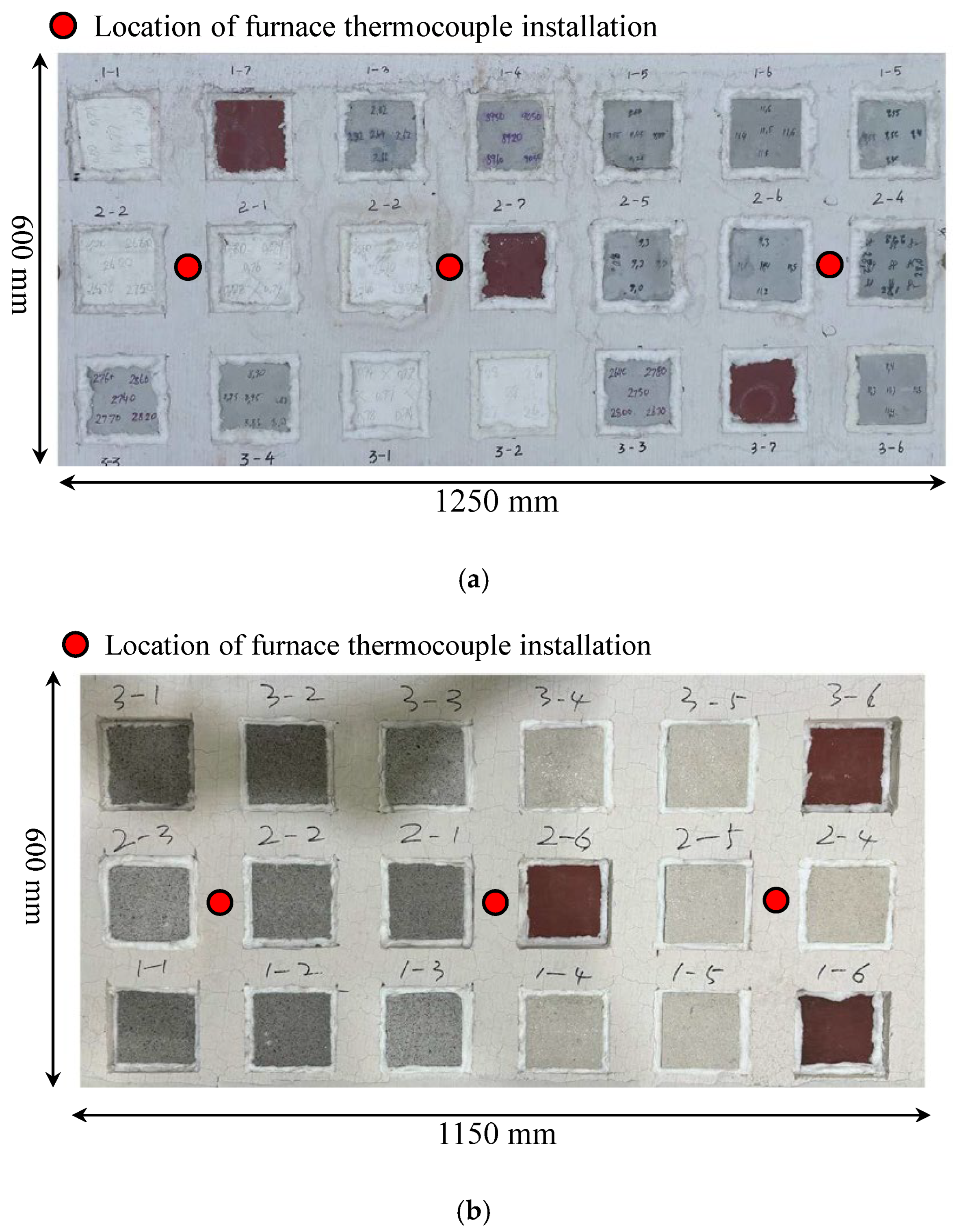

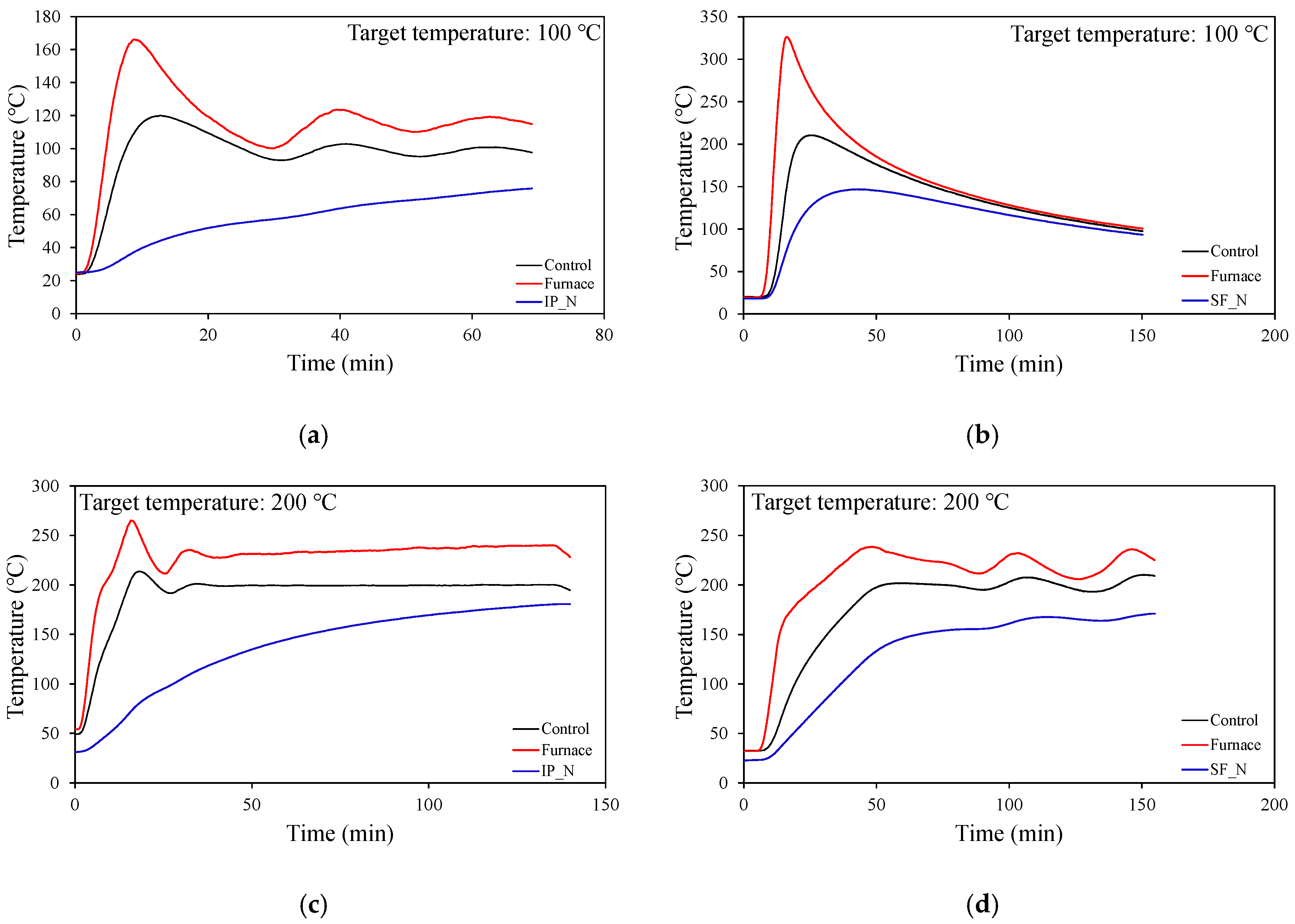
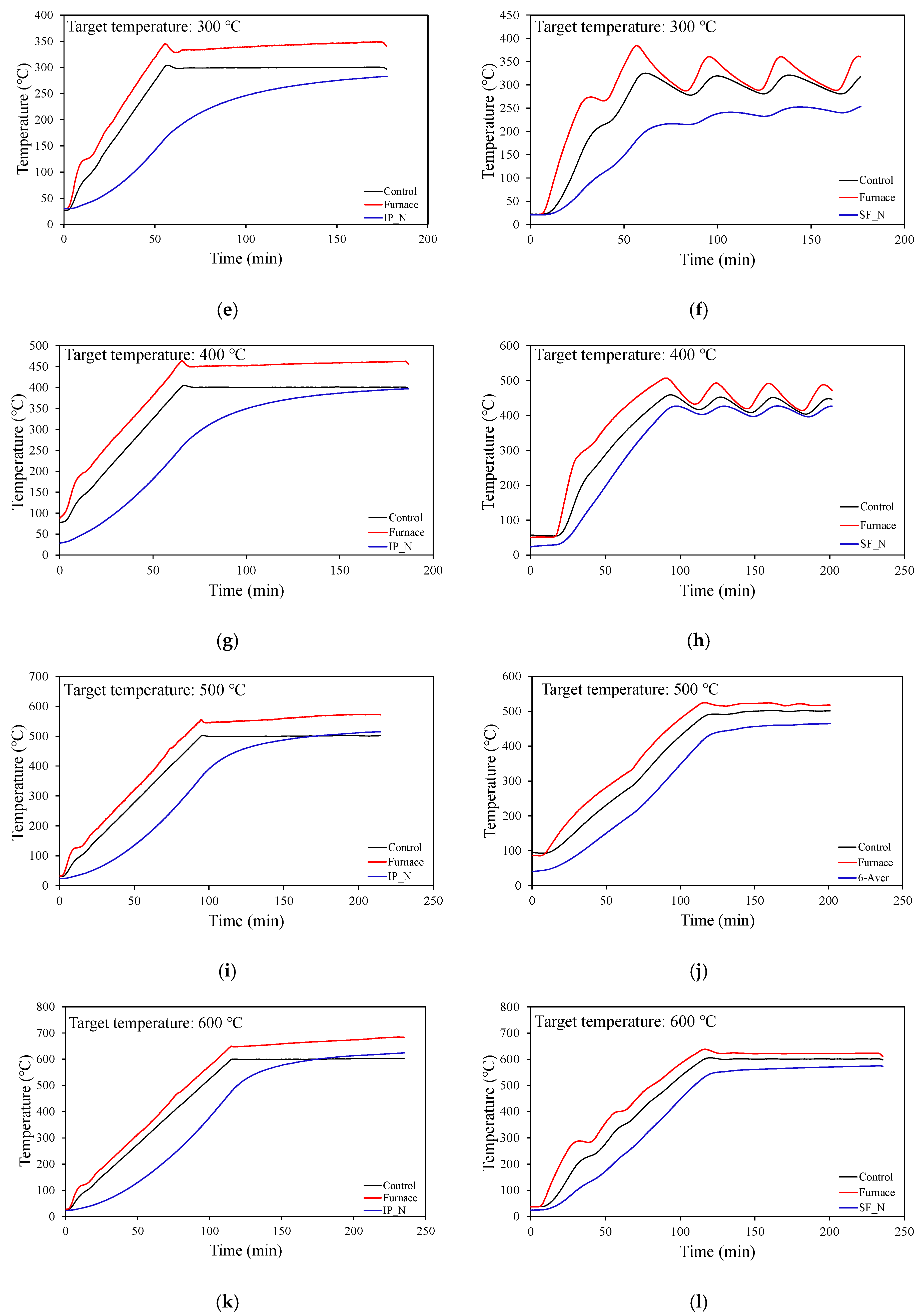

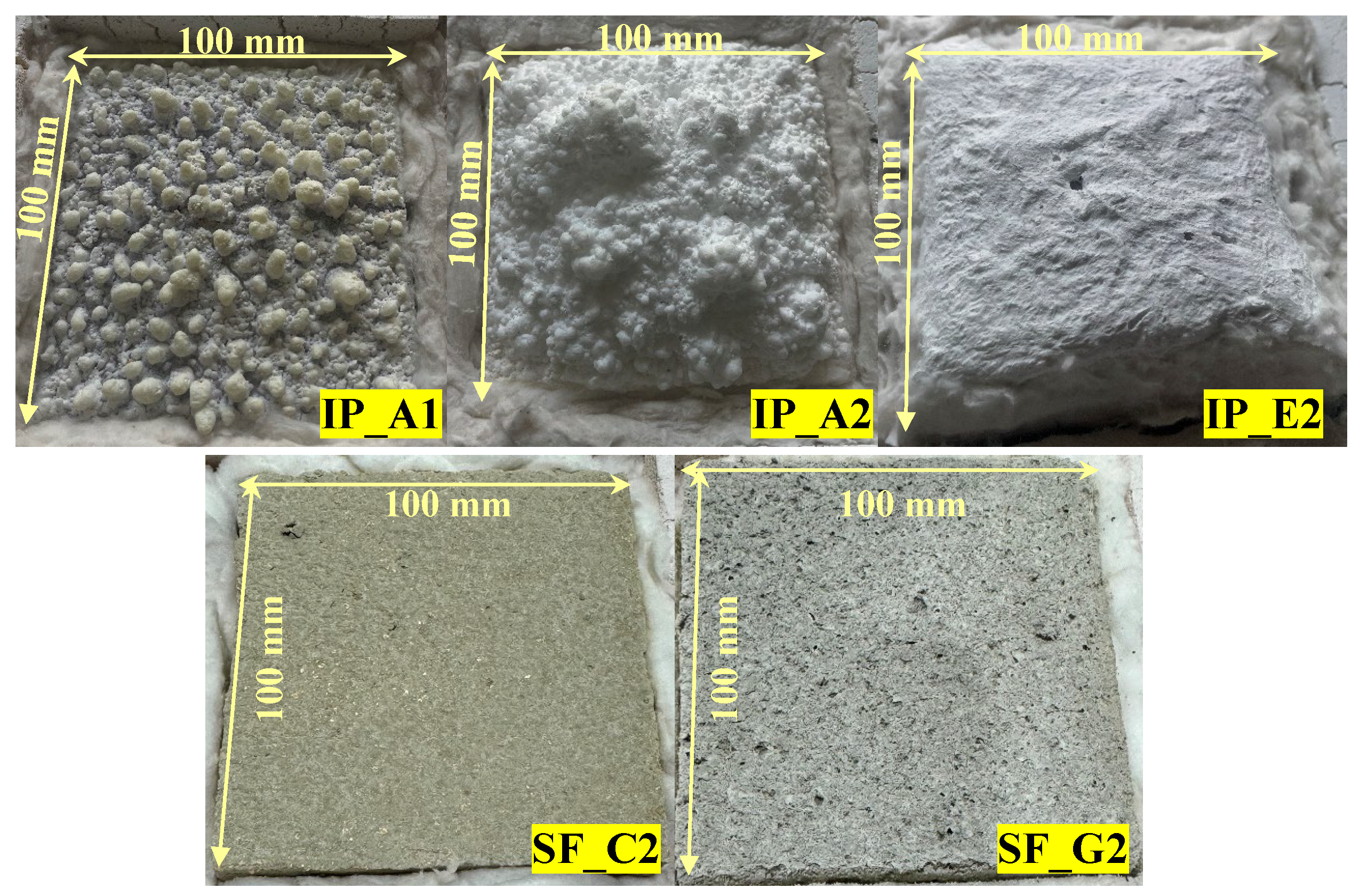
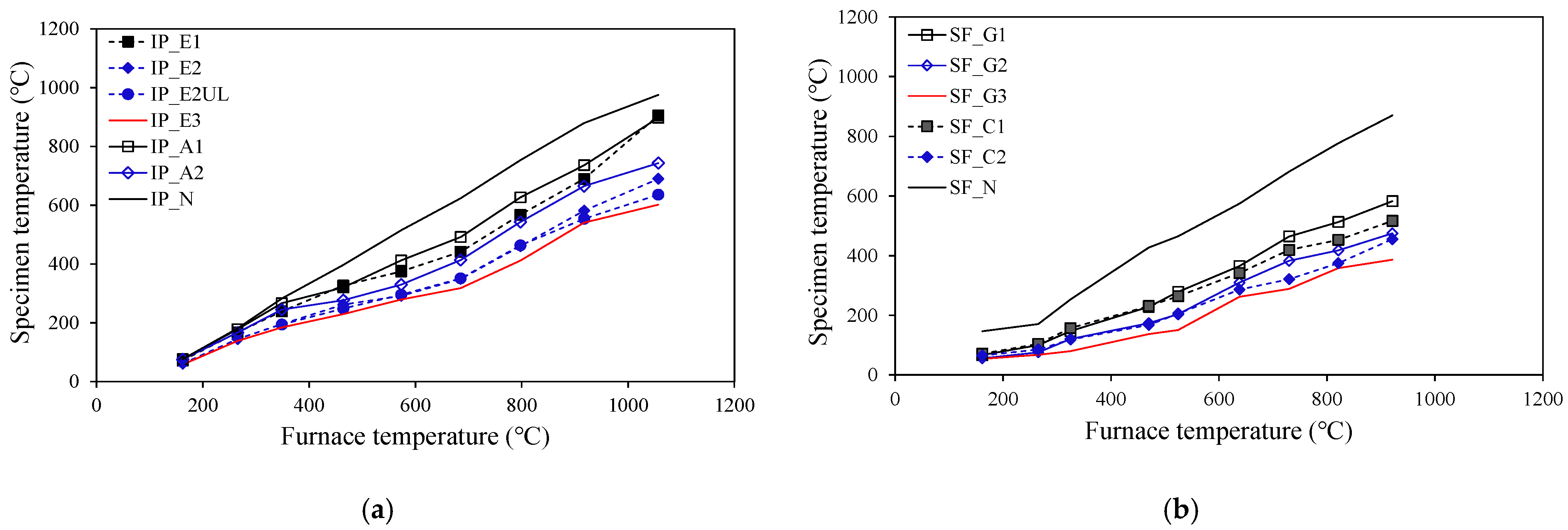


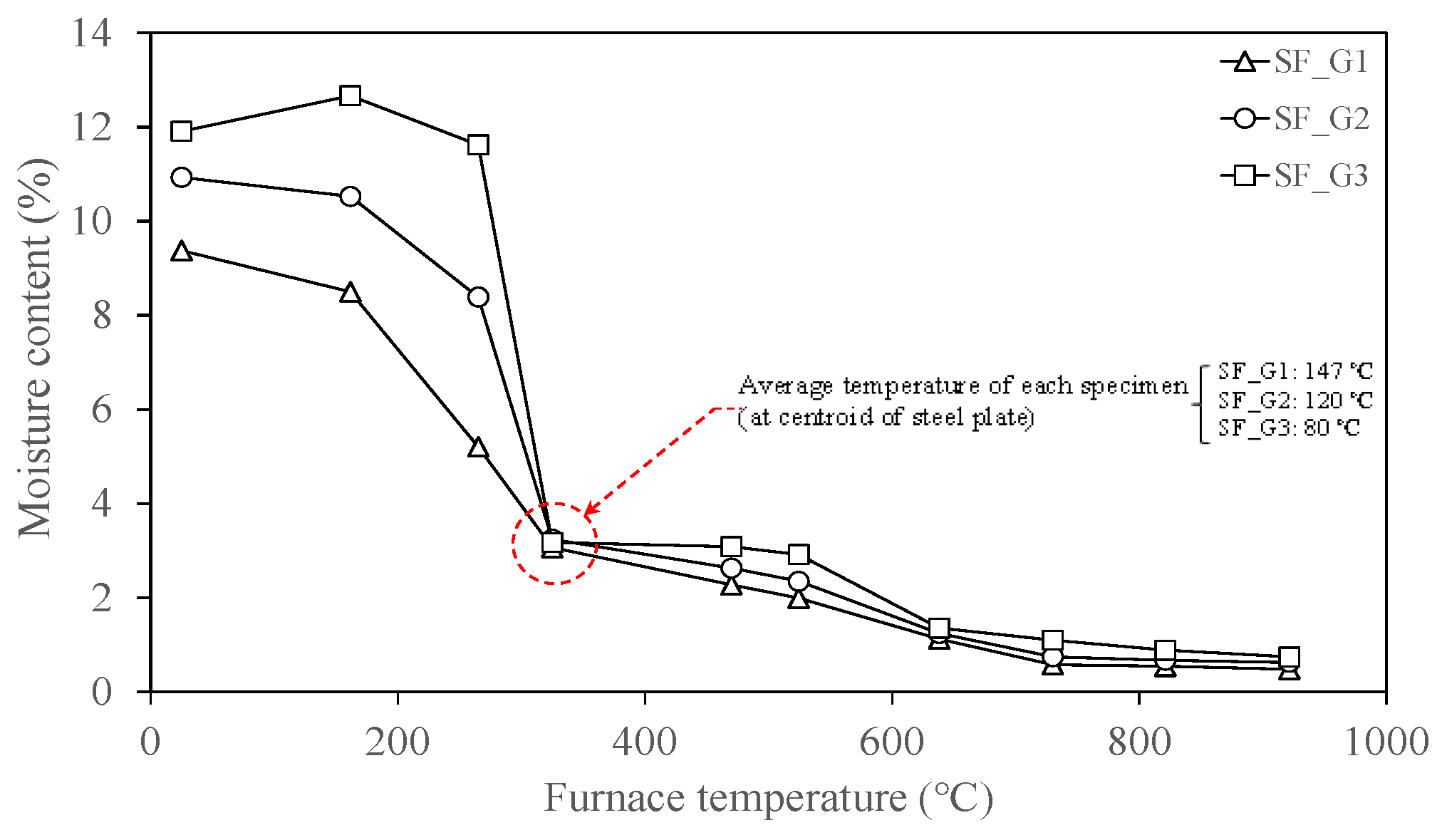

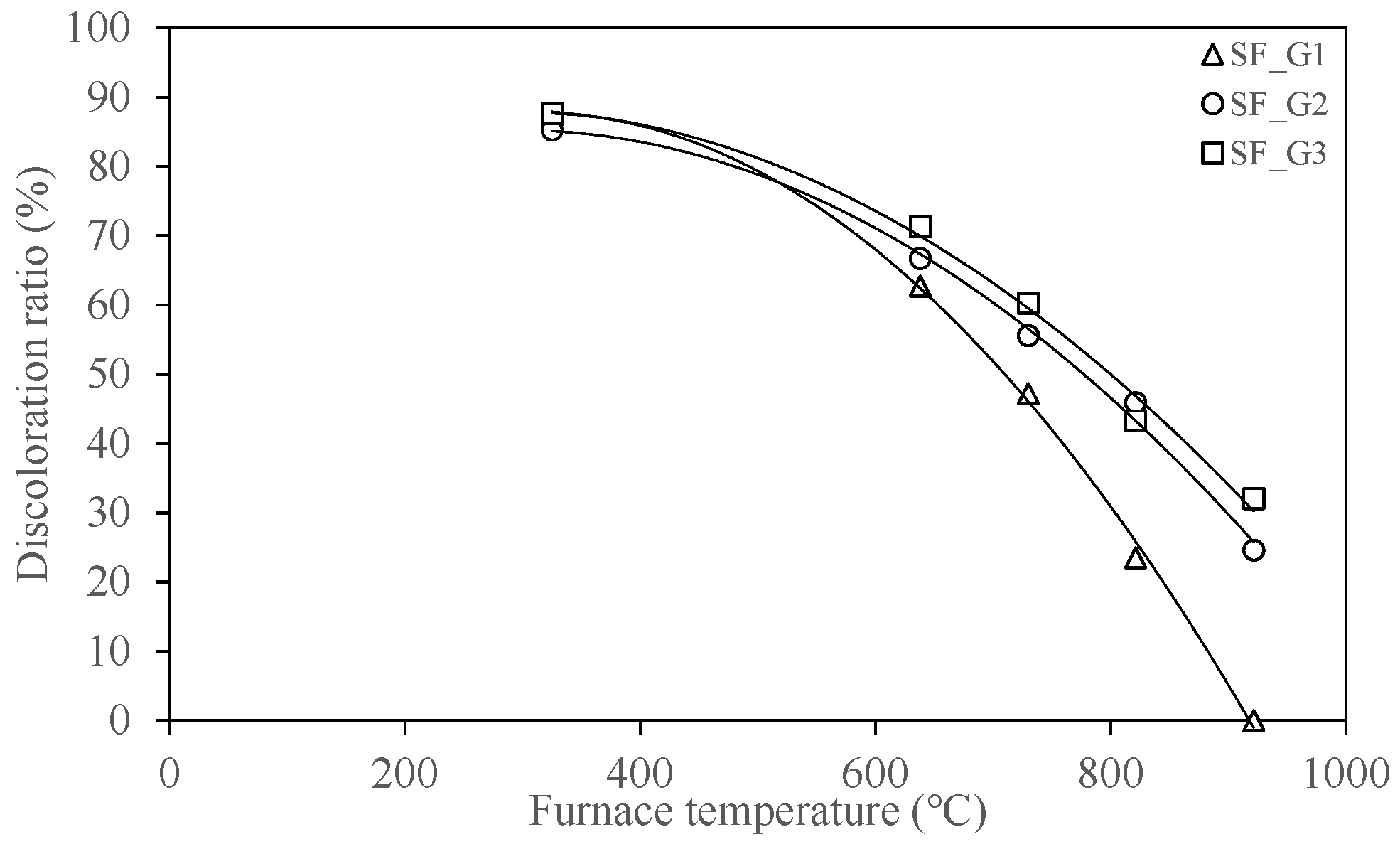
| Experimental Series (Paint and Sprayed) | Thickness of Fireproof Material—‘Data ID’ (Fire Resistance Certification Time, Hour) | Steel Plate | Target Temperature °C | ||
|---|---|---|---|---|---|
| Plane (mm) | Thickness (mm) | ||||
| Intumescent Paint (IP) | Epoxy type | 2.65 mm—‘IP_E1’ (1 H) | 100 × 100 | 20 | 25 (ambient) 100 200 300 400 500 600 700 800 900 |
| 8.90 mm—‘IP_E2’ (2 H) | |||||
| 9.22 mm—‘IP_E2UL’ (2 H in UL) | |||||
| 11.20 mm—‘IP_E3’ (3 H) | |||||
| Acrylic type | 0.75 mm—‘IP_A1’ (1 H) | ||||
| 2.60 mm—‘IP_A2’ (2 H) | |||||
| Non-cover | 0 mm—‘IP_N’ | ||||
| Spray-on Fireproofing (SFRM) | Gypsum type | 10 mm—‘SF_G1’ (1 H) | |||
| 20 mm—‘SF_G2’ (2 H) | |||||
| 30 mm—‘SF_G3’ (3 H) | |||||
| Cement type | 21 mm—‘SF_C1’ (1 H) | ||||
| 32 mm—‘SF_C2’ (2 H) | |||||
| Non-cover | 0 mm—‘SF_N’ | ||||
Disclaimer/Publisher’s Note: The statements, opinions and data contained in all publications are solely those of the individual author(s) and contributor(s) and not of MDPI and/or the editor(s). MDPI and/or the editor(s) disclaim responsibility for any injury to people or property resulting from any ideas, methods, instructions or products referred to in the content. |
© 2025 by the authors. Licensee MDPI, Basel, Switzerland. This article is an open access article distributed under the terms and conditions of the Creative Commons Attribution (CC BY) license (https://creativecommons.org/licenses/by/4.0/).
Share and Cite
Kang, H.; Kweon, O.-S. Behavior and Performance Analysis of Fire Protection Materials Applied to Steel Structures According to Exposed Temperatures. Materials 2025, 18, 1285. https://doi.org/10.3390/ma18061285
Kang H, Kweon O-S. Behavior and Performance Analysis of Fire Protection Materials Applied to Steel Structures According to Exposed Temperatures. Materials. 2025; 18(6):1285. https://doi.org/10.3390/ma18061285
Chicago/Turabian StyleKang, Hyun, and Oh-Sang Kweon. 2025. "Behavior and Performance Analysis of Fire Protection Materials Applied to Steel Structures According to Exposed Temperatures" Materials 18, no. 6: 1285. https://doi.org/10.3390/ma18061285
APA StyleKang, H., & Kweon, O.-S. (2025). Behavior and Performance Analysis of Fire Protection Materials Applied to Steel Structures According to Exposed Temperatures. Materials, 18(6), 1285. https://doi.org/10.3390/ma18061285






